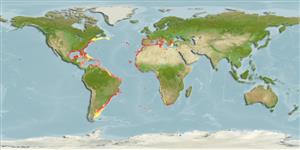>
Scombriformes (Mackerels) >
Scombridae (Mackerels, tunas, bonitos) > Scombrinae
Etymology: Scomber: Greek, skombros = tunny or mackerel, 1623 (Ref. 45335).
More on author: Gmelin.
Environment: milieu / climate zone / depth range / distribution range
Ökologie
seewasser; brackwasser. Temperate; 46°N - 65°S, 98°W - 42°E
Atlantic Ocean. Warm water; eastern and western coasts, including the Mediterranean and southern Black Sea. Replaced by Scomber japonicus in the Indo-Pacific.
Length at first maturity / Size / Gewicht / Alter
Maturity: Lm 21.3 range ? - ? cm
Max length : 55.0 cm TL Männchen/unbestimmt; (Ref. 121850)
Adults and juveniles feed mainly on zooplankton, with relative importance of larger organisms such as cephalopods, crustaceans and small pelagic fish increases with the size of individuals. Caught mostly in purse seine and pelagic trawl fisheries which target sardine and/or anchovy. Usually a by-catch but when availability of target species is low, this species provided an alternative income (Ref. 121850)
Collette, B.B., 1999. Mackerels, molecules, and morphology. p. 149-164. In B. Séret and J.-Y. Sire (eds.) Proc. 5th Indo-Pac. Fish Conf., Noumea, Paris. (Ref. 33246)
IUCN Rote Liste Status (Ref. 130435)
Bedrohung für Menschen
Harmless
Nutzung durch Menschen
Fischereien: weniger kommerziell
Mehr Information
PartnerBilderStamps, Coins Misc.LauteCiguateraGeschwindigkeitSchwimmstilKiemenoberflächeOtolithsGehirngrößeSehfähigkeit
Tools
Zusatzinformationen
Download XML
Internet Quellen
Estimates based on models
Preferred temperature (Ref.
123201): 13.9 - 27.3, mean 22.5 °C (based on 492 cells).
Phylogenetic diversity index (Ref.
82804): PD
50 = 0.5625 [Uniqueness, from 0.5 = low to 2.0 = high].
Bayesian length-weight: a=0.00741 (0.00478 - 0.01150), b=3.03 (2.90 - 3.16), in cm total length, based on LWR estimates for this species & (Sub)family-body (Ref.
93245).
Trophic level (Ref.
69278): 3.9 ±0.63 se; based on food items.
Generation time: 4.5 (3.4 - 5.5) years. Estimated as median ln(3)/K based on 15
growth studies.
Widerstandsfähigkeit (Ref.
120179): mittel, Verdopplung der Population dauert 1,4 - 4,4 Jahre. (Preliminary K or Fecundity.).
Prior r = 0.60, 95% CL = 0.39 - 0.90, Based on 6 stock assessments.
Fishing Vulnerability (Ref.
59153): Moderate vulnerability (42 of 100).
Nutrients (Ref.
124155): Calcium = 21.2 [8.1, 51.9] mg/100g; Iron = 0.69 [0.26, 1.60] mg/100g; Protein = 20.7 [19.5, 21.9] %; Omega3 = 0.739 [0.500, 1.145] g/100g; Selenium = 42.7 [22.3, 80.3] μg/100g; VitaminA = 20.1 [6.0, 80.7] μg/100g; Zinc = 0.688 [0.442, 1.014] mg/100g (wet weight); based on
nutrient studies.
